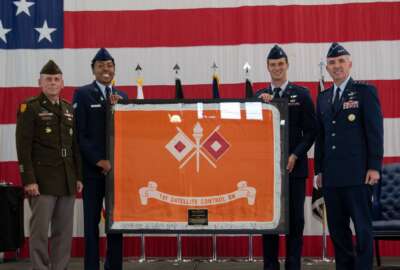
The Space Development Agency found ways to condense the timeline for its low earth orbit satellites.
When the Space Force’s Space Development Agency (SDA) launched 10 of 28 new satellites last week, it highlighted another victory for the new service. Space Force proved it could execute a speedy, agile procurement process capable of responding to evolving technology, and do it in just 30 months.
The quick turnaround started with solicitations in 2021 and in two-and-a-half years, the satellites went from authority to proceed and then on to launch. The acquisition model follows the Space Force’s plan for a hybrid satellite mix where large and small satellites launch into high and low orbits. The recent launch of the low earth orbit (LEO) satellites met the requirements of being cheaper and faster to produce, with capabilities similar to commercial satellites.
“The department and the Space Force are completely behind this model where we do rapid prototyping and fielding, we operate that for a limited lifetime, say five years, and we continue to build that up. That’s the model. If anything, this launch has shown that it is a feasible model. One can actually build and launch these satellites on the timeframes that we proposed,” said SDA Director Derek Tournear at the Mitchell Institute’s Spacepower Security Forum on Wednesday.
SDA plans several tranches of the relatively cheap LEO satellites. The rest of the 28 satellites in tranche zero will launch in July. Tournear said the first tranche of satellites will be for communications and training. The first operational missile warning and tracking satellites will come with tranche one.
While those first groups of satellites go through a delivery and launch phase, plans are already underway for tranche two with what SDA calls an alpha, beta and gamma solicitation. The beta solicitation will go out later in April. Tournear said potential vendors should be ready for multiple solicitations.
“As soon as you all turn in your proposals for beta, we’re going to go into source selection, but we’re not going to give you a chance to rest when we’re doing source selection, we’re going to then release our alpha solicitation,” he said.
While Space Force leaders are taking a victory lap after successful acquisition of the LEO satellites, they acknowledged part of the credit goes to Air Force space acquisitions chief Frank Calvelli. The program directly ties to the first of Calvelli’s nine tenets of acquisition of which the first is “build smaller satellites, smaller ground systems and minimize non-recurring engineering.”
“SDA so far, is really doing a great job. I think they are the role model for us all to emulate, in terms of their ability to get things done quickly and the way they do their contracting,” Calvelli said at the Defense and Intelligence in Space Conference on Jan. 24.
Calvelli’s acquisition tenets also include awarding executable contracts and then making sure they get delivered on time, on cost and with capabilities that work.
“The traditional ways of doing space acquisition must be reformed in order to add speed to our acquisitions to meet the priorities of the department,” Calvelli said. “To gain speed, we must shorten development timelines by building smaller systems and by acquiring ground and software intensive systems in smaller more manageable pieces that we can deliver faster by using existing technology and enable speed by taking advantage of commercial systems.”
SDA’s satellite acquisition program has several phases and will go on for multiple years. The recently launched tranche zero satellites did experience some delays and a cost overrun. SDA originally planned for delivery in 2022 with an average price of $14.1 million per satellite. The average price turned out to be closer to $15 million per unit.
Tournear said SDA plans to launch the 150 tranche one satellites starting in September and continuing with a launch a month for about a year.
Copyright © 2025 Federal News Network. All rights reserved. This website is not intended for users located within the European Economic Area.
Alexandra Lohr, a former staff member, covered the Defense Department for Federal News Network until September 2023.
